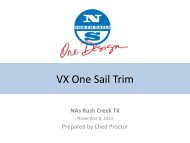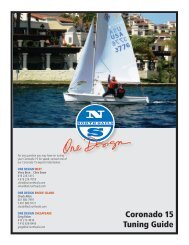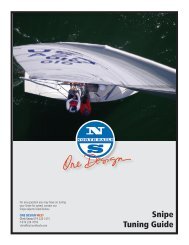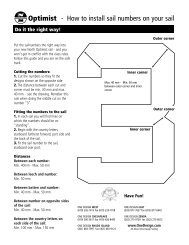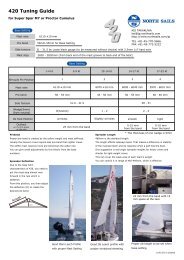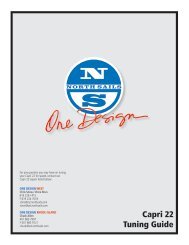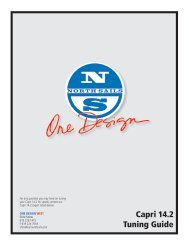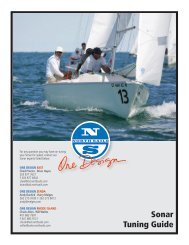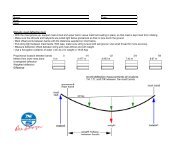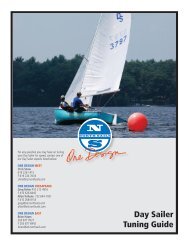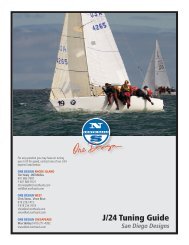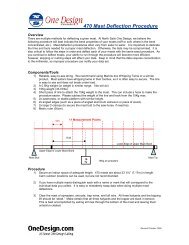Etchells Tuning Guide - North Sails One Design North America
Etchells Tuning Guide - North Sails One Design North America
Etchells Tuning Guide - North Sails One Design North America
Create successful ePaper yourself
Turn your PDF publications into a flip-book with our unique Google optimized e-Paper software.
For any question you may have<br />
on tuning your <strong>Etchells</strong> for speed,<br />
contact one of our <strong>Etchells</strong> experts<br />
listed below:<br />
ONE DESIGN WEST<br />
Vince Brun . Chris Snow<br />
619 226 1415 F 619 224 7018<br />
chris@od.northsails.com<br />
vince@od.northsails.com<br />
ONE DESIGN EAST<br />
Ched Proctor<br />
203 877 7627 F 203 877 6942<br />
ched@od.northsails.com<br />
ONE DESIGN RHODE ISLAND<br />
Chuck Allen<br />
401 683 7997 F 401 683 9121<br />
chuck@od.northsails.com<br />
ONE DESIGN CHESAPEAKE<br />
Allan Terhune<br />
732 644-1051 F 410 268-8155<br />
allan@od.northsails.com<br />
<strong>Etchells</strong><br />
<strong>Tuning</strong> <strong>Guide</strong>
NORTH SAILS<br />
Congratulations on your purchase of <strong>North</strong><br />
<strong>One</strong> <strong>Design</strong> <strong>Etchells</strong> sails. The following<br />
tuning guide is meant to be a good<br />
starting point in setting up your boat.<br />
Depending on your total crew weight,<br />
wind strength, sailing style and sea<br />
conditions, you may have to alter your rig<br />
slightly. As you read this, write down any<br />
questions you might have, and we will be<br />
happy to discuss them with you in more<br />
detail.<br />
We are trying to achieve a rig set up that is<br />
fast in all conditions: upwind, reaching and<br />
running. Your new <strong>North</strong> sails are designed<br />
around this “all purpose“ philosophy.<br />
Rig Set Up<br />
SPREADER ANGLE<br />
Before stepping your mast make sure<br />
your spreaders are the same length by<br />
measuring from the shrouds perpendicular<br />
to the side of the mast. The spreaders<br />
should be fixed in place straight out or<br />
slightly swept forward. Also, place 2 tape<br />
marks on the spreaders 1’ 6 ¼” and 1’ 9<br />
¾” from the side of the mast. These are<br />
used to reference jib sheet tension.<br />
MAST POSITION<br />
The mast step position controls the prebend.<br />
Having the correct amount of prebend<br />
translates on the correct forestay sag,<br />
and therefore superior speed. The pre-bend<br />
is mainly generated by the offset position<br />
on your mast partner, and the alignment<br />
of the mast step and the hounds. Since<br />
in most boats the mast partners distance<br />
from the transom varies, to get the prebend<br />
right, you have to first to locate the<br />
partner position on your own boat.<br />
This is what we recommend:<br />
1. Make a mark on the center line of the<br />
aft deck, 12 feet from the aft edge of the<br />
mast partner. Normally we add a thin aft<br />
partner block (1/4 inch ) for the standard<br />
upwind setting. The measurement should<br />
include this block.<br />
2. From this mark on the aft deck measure<br />
12' 6 3/8" to the intersection of the aft<br />
face of the mast and make new mark on<br />
the mast step "I" beam. This is now your<br />
new baseline mast step position, for winds<br />
between 6 to 9 knots.<br />
MAST STEP CHART<br />
0 to 5 knots aft 1/4"<br />
6 to 9 knots neutral<br />
10 to 14 knots forward 1/4"<br />
15 to 20 knots forward 1/2"<br />
20+ knots forward 3/4"<br />
MAST RAKE<br />
Once the mast is stepped, lay your forestay<br />
taught against the front of the mast,<br />
and mark the forestay at the point that<br />
corresponds to the upper edge of the<br />
black band on the mast at the gooseneck.<br />
12 feet<br />
12’ 6 3/8”<br />
Visit our web site at www.<strong>One</strong><strong>Design</strong>.com for the latest <strong>Etchells</strong> news and tuning tips.<br />
© 2008 <strong>North</strong> <strong>Sails</strong> <strong>One</strong> <strong>Design</strong>. All rights reserved.<br />
<strong>Etchells</strong> <strong>Tuning</strong> <strong>Guide</strong><br />
Hook the forestay back on and lengthen<br />
the headstay until it measures 46” from<br />
the corresponding mark at the forestay<br />
to the deck ” (46 ½” should be used<br />
for newer boats with keel further aft).<br />
Before attaching the backstay, make<br />
a similar black band reference mark<br />
on the backstay. Remember, that the<br />
measurements you are taking correspond<br />
to the top of the gooseneck band. In some<br />
conditions a headstay setting of 47” has<br />
proven fast. If you change your headstay,<br />
please realize that you need to re-locate<br />
your mast step position.<br />
UPPER & LOWER SHROUD POSITION<br />
AND TENSION<br />
The upper and lower shrouds affect the<br />
mast differently. The tension on the uppers<br />
affects the fore and aft bend. Tight uppers<br />
(30 on Loos gage) will make the mast<br />
stiffer fore and aft, and loose uppers (22)<br />
will make the mast softer. The lowers<br />
affect the amount of middle mast sag (side<br />
bend). Having the right amount of middle<br />
mast sag is crucial to proper mainsail<br />
shape and helm balance.<br />
Think of the middle mast sag as similar to<br />
how the headstay sag effects the jib. More<br />
middle mast sag in light air powers up the<br />
mainsail, and less sag in heavy air helps<br />
de-power the mainsail. When you first set<br />
1
NORTH SAILS<br />
your boat up, you want to start out with<br />
your uppers tensioned at 25 on the Loos<br />
tension gage Model B. The lowers should<br />
be set very loose with 8” of horizontal<br />
slop. Once you have tightened your uppers<br />
to 25, use your jib halyard to center your<br />
mast in the boat, checking side to side,<br />
before you continue with the tuning. When<br />
checking shroud tension, pull sufficient<br />
tension on the backstay to remove slack<br />
in the headstay. Final adjustment of the<br />
lowers should be made while sailing by<br />
judging the degree of mast sag. See the<br />
chart below.<br />
The following chart gives you specifics<br />
depending on the wind strength.<br />
“Hole number” refers to the chainplate<br />
position the shrouds should be attached<br />
to, counting from the front. The lowers<br />
should always be in the fourth hole aft on<br />
the chainplates.<br />
Tension is measured with the Loos tension<br />
gauge Model B.<br />
WIND<br />
SPEED<br />
0 - 6 knots<br />
7 - 11<br />
12 - 18<br />
19 and<br />
above<br />
UPPERS<br />
TENSION LOWERS<br />
20 tension<br />
hole #2<br />
23 tension<br />
hole #2<br />
27 tension<br />
hole #2<br />
30 tension<br />
hole #6<br />
1” sag<br />
1/2” sag<br />
Straight<br />
mast<br />
(no sag)<br />
Mast will<br />
sag above<br />
spreader<br />
MAST bLOCKS<br />
The function of the mast blocks is to<br />
adjust the bend in the mast for the<br />
conditions. Combined with the backstay<br />
and mainsheet tension, the mast blocks<br />
will control the bend of the mast and sag<br />
of the headstay, which helps the main<br />
and jib achieve a fast sail shape for the<br />
wind strength. When blocks are added in<br />
front of the mast, (step block raised) the<br />
bend is taken out, stiffening the mast for<br />
heavier air. This will have a great influence<br />
in decreasing your headstay sag. As the<br />
blocks are taken out from the front of the<br />
mast, (step block lowered) the mast is<br />
allowed to bend which moves the draft<br />
aft in the main, and adds to headstay sag.<br />
The added low bend in the mast, allows<br />
the top of the main to become fuller. The<br />
net affect is to power up the main and jib,<br />
increasing helm.<br />
If the mainsail looks too flat, or the<br />
headstay looks too loose, producing<br />
excessive weather helm, the mast should<br />
be moved back at the partners or if not<br />
possible (because mast is always back<br />
at partners), then the mast step should<br />
be moved forward. If the mainsail looks<br />
TRUE WIND<br />
SPEED<br />
MAST POSITION<br />
AT THE PARTNERS<br />
Visit our web site at www.<strong>One</strong><strong>Design</strong>.com for the latest <strong>Etchells</strong> news and tuning tips.<br />
© 2008 <strong>North</strong> <strong>Sails</strong> <strong>One</strong> <strong>Design</strong>. All rights reserved.<br />
<strong>Etchells</strong> <strong>Tuning</strong> <strong>Guide</strong><br />
full (round in the lower front area) and<br />
the headstay is too tight, move the mast<br />
forward at the partners or move the step<br />
aft.<br />
The following chart is to provide a guide<br />
for the mast position in the partners when<br />
measured forward from the back end of<br />
the mast partner.<br />
bACKSTAy<br />
The backstay controls the mainsail shape,<br />
the amount of twist in the mainsail and<br />
the amount of headstay sag you will have.<br />
Before attaching the backstay, make a<br />
similar black band reference mark as you<br />
did on the forestay. After you have the<br />
backstay attached, measure down from<br />
the black band reference mark and make<br />
marks from 48” to 56”. Those marks<br />
should describe the full range of backstay<br />
that will be played; the 48” mark is for<br />
very heavy winds and the 56” mark for<br />
super light conditions. The measurements<br />
in the table below provide a rough range<br />
of backstay adjustment for different wind<br />
velocities.<br />
MAST STEP<br />
0 - 5 knots 1/2” block behind mast Base<br />
6 - 9 knots<br />
10 - 15 knots<br />
Mast blocked ¼” from back of<br />
partner<br />
Mast blocked ¼” from back of<br />
partner<br />
Base<br />
1/4” forward of base<br />
16+ knots Mast aft against partner 1/2” forward of base<br />
2
NORTH SAILS<br />
MAIN CUNNINGHAM<br />
Cunningham should not be used until 15<br />
knots and more.<br />
Jib Settings<br />
JIb LEAD<br />
The measurement for an average lead<br />
position is 8’ 6 ½” from headstay at the<br />
deck to the middle of the jib car. To add<br />
power to the jib the lead can be moved<br />
forward as much as ¾”. Remember<br />
though, the lead position will have to be<br />
adjusted with any jib halyard changes. We<br />
have found that when the jib lead is set<br />
properly, the foot sets very flat.<br />
Jib twist and sheet tension - We sail<br />
with two black bands on the spreaders<br />
as described in the “Rig set up” section.<br />
Measuring from the side of the mast along<br />
the spreader to the inside band should be<br />
1’ 6 ¼”. The outside band measures 1’<br />
9 ¾” from the mast to the band. Using<br />
these bands allows the leech of the jib<br />
to be adjusted while looking through<br />
MAINSAIL SETTINGS<br />
the spreader window of the mainsail,<br />
and increases sheet tension accuracy for<br />
different conditions. In light air, the leech<br />
of the jib should fall just inside the outside<br />
band. As the breeze builds the sheet<br />
tension will get tighter, up to the point<br />
where the leech of the jib is at the inside<br />
band. As the breeze and sea conditions<br />
build, the sheet will be adjusted to keep<br />
the leech between the bands. In 18+ knots<br />
the leech will line up with the middle of<br />
the outside band. In huge puffs you may<br />
want to be even further out to help keep<br />
the boat in control.<br />
On all our jibs we have placed a leech<br />
tell tale between the two top battens.<br />
This leech tell tale, will help determine<br />
the correct sheet tension. For best<br />
performance, the leech tale should be on<br />
the verge of stalling at all times.<br />
Jib halyard tension - We have a jib halyard<br />
with 2 balls at 1” increments. Together<br />
with the jib halyard fine tune we get plenty<br />
of adjustability as the breeze increases<br />
and decreases. As a starting point the jib<br />
halyard should be adjusted with the tack<br />
Visit our web site at www.<strong>One</strong><strong>Design</strong>.com for the latest <strong>Etchells</strong> news and tuning tips.<br />
© 2008 <strong>North</strong> <strong>Sails</strong> <strong>One</strong> <strong>Design</strong>. All rights reserved.<br />
<strong>Etchells</strong> <strong>Tuning</strong> <strong>Guide</strong><br />
Wind speed Traveler Backstay Top batten angle Outhaul<br />
0 - 6 knots + 10” 56- 54"<br />
7 - 11 + 5” 56- 54"<br />
12 - 16 Center 54- 52"<br />
Open 3 degrees<br />
Tellales stalling 50% of the time<br />
Parallel to close 3 degrees<br />
Top telltale stalled 30%<br />
Parallel to close 3 degrees<br />
Top telltale flying all the time<br />
1” from band<br />
1” from band<br />
Maximum<br />
17 - 19 - 2” 52-50" Parallel to close 3 degrees Maximum<br />
20+ - 6” 49-48" Open 3-6 degrees Maximum<br />
of the jib about 3” from the deck. In light<br />
to medium winds adjust the halyard so<br />
wrinkles are barely visable at each tab.<br />
For fine-tuning adjustments of luff tension<br />
on the jib the adjusting the tack is<br />
recommended. Completely releasing the<br />
tack control will quickly add power to the<br />
sail for acceleration out of tacks.<br />
In light to medium conditions, for<br />
maximum power, the jib luff should have<br />
very little tension and some scallops<br />
should be noticed.<br />
In breezy conditions, tension the luff<br />
quite hard to depower and hold the draft<br />
forward.<br />
Our latest <strong>North</strong> <strong>Sails</strong> jibs are made<br />
standard with “dual set of tabs” for added<br />
wind range and versatility. Using the<br />
long tabs will add fullness and allow for<br />
a tighter headstay in choppy conditions.<br />
Generally we use the long tabs in winds<br />
below 12-15 knots. As a general rule, if<br />
you are not pulling on the backstay to<br />
depower, it is probably faster to use the<br />
long tabs.<br />
3
NORTH SAILS<br />
SPECIAL NOTE ON THE TOP bATTEN<br />
POCKET fOR yOUR NORTH SAILS<br />
ETCHELLS JIb<br />
Your jib comes with both a long and a<br />
short top batten and the pockets for these<br />
are mounted back to back near the head<br />
of the sail. Using in the long top batten<br />
can increase the effective wind range of<br />
your jib and also give the sail a longer life<br />
when it gets older.<br />
We suggest always using the short top<br />
batten in your jib and then when the<br />
winds gets up to the top of the range of<br />
the sail or when the sail gets a little older<br />
add the full length top batten and sail with<br />
both in place. Any questions, please give<br />
us a call.<br />
Spinnaker Settings<br />
RIG SETUP WHILE RUNNING<br />
Getting the mast raked as far forward as<br />
possible is critical to downwind speed.<br />
Take out all the blocks in front of the mast<br />
(completely lower the step block) after you<br />
get the spinnaker up. Ease the backstay off<br />
until the mast just rest on the front of the<br />
partners. The tip of the mast has moved<br />
through several feet, and the entire mast<br />
is now angling forward in the boat. To<br />
keep the mast from jumping around, it is<br />
common to have a separate piece of line<br />
attached to your jib tack shackle with a<br />
clip at the other end. Lower the jib to the<br />
deck, and attach the clip to the jib halyard<br />
shackle on the jib head. Pull the jib halyard<br />
tight.<br />
Keep the inboard end of the pole<br />
approximately 30” above the gooseneck<br />
band. Under 8 knots of wind, the pole<br />
angle should be about 2 - 4” lower at the<br />
outboard end. In 8 - 13 knots of breeze<br />
the pole should be about parallel to the<br />
water. In over 13 knots, the pole should be<br />
raised as much as 6 additional inches at<br />
the outboard end.<br />
Sail Care<br />
Always store your sails away from the<br />
sun and make sure they are clean and<br />
completely dry.<br />
Be sure that you always “roll “ your<br />
upwind sails. This will help then last longer<br />
and remain wrinkle free.<br />
If you have any questions or comments<br />
about our <strong>Etchells</strong> <strong>Tuning</strong> <strong>Guide</strong>, don’t<br />
hesitate to contact us anytime.<br />
Visit our web site at www.<strong>One</strong><strong>Design</strong>.com for the latest <strong>Etchells</strong> news and tuning tips.<br />
© 2008 <strong>North</strong> <strong>Sails</strong> <strong>One</strong> <strong>Design</strong>. All rights reserved.<br />
<strong>Etchells</strong> <strong>Tuning</strong> <strong>Guide</strong><br />
TENSION GAUGE CONVERSION<br />
CHART<br />
Over the past few year Loos Co. has<br />
introduced it's new style PT-1, 2 and 3<br />
professional tension gauges to the market.<br />
Since many of us are replacing our older<br />
model A and B gauges with these new<br />
models we are posting the following<br />
conversion chart for your convenience.<br />
MODEL A MODEL PT-1<br />
3/32 1/8 5/32<br />
5 6<br />
10 9<br />
15 12 14<br />
20 16 16<br />
25 20 19<br />
28 23 21<br />
30 22<br />
35 27 25<br />
38 30 28<br />
40 33 30<br />
42 33<br />
44 36<br />
45 38<br />
46 39<br />
47 40<br />
Model b Model PT-2 PT-3<br />
3/16 7/32 1/4 9/32<br />
10 11<br />
15 13<br />
18 15<br />
20 16 18<br />
22 18 20<br />
24 19 22<br />
26 21 24<br />
28 23 25<br />
30 25 27 25<br />
32 27 29 27<br />
34 29 31 29<br />
33 31<br />
36 33 6<br />
37 36 7<br />
37 9<br />
10<br />
11<br />
12<br />
14<br />
16<br />
18<br />
20<br />
25<br />
4
NORTH SAILS<br />
NORTH SAILS ONE DESIGN QUALITy<br />
CONTROL CHECK<br />
MAINSAIL JIb SPINNAKER<br />
Corners Corners Corners<br />
Cunningham Leech Telltales<br />
Visit our web site at www.<strong>One</strong><strong>Design</strong>.com for the latest <strong>Etchells</strong> news and tuning tips.<br />
© 2008 <strong>North</strong> <strong>Sails</strong> <strong>One</strong> <strong>Design</strong>. All rights reserved.<br />
<strong>Etchells</strong> <strong>Tuning</strong> <strong>Guide</strong><br />
Numbers and Country Code<br />
(one side)<br />
Tack Slug Luff Tabs Brummel Hooks (optional)<br />
Numbers Telltales <strong>North</strong> Logo<br />
Battens Battens Velcro<br />
Batten loader Foot cord<br />
Leech Cord Leech cord<br />
Leech Telltale <strong>North</strong> Logo<br />
Insignia Bag<br />
Country Code<br />
<strong>North</strong> Logo<br />
Bag<br />
Checked by: _____________________<br />
Date: ____ / ____ / ____<br />
5



